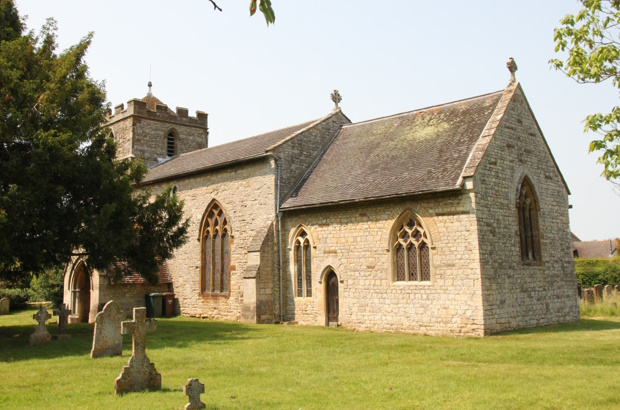


























The Church of St. Michael and All Angels, Finmere
The church of St. Michael and All Angels in Finmere, which has been much restored, comprises a nave and chancel, separated by a chancel arch, a western tower, south porch, and north aisle. The north wall of the chancel, the battlemented tower of three stages and most of the windows are the only survivals of the 14thcentury church. By the mid-17th century the fabric was in a precarious condition, for an entry of 1651 in the registers records that the walls 'were propt with timber'. In 1664 the churchwardens reported that their church was 'in decay and ready to fall', and that the two lords of the manor had covenanted with the parishioners to rebuild it. In 1668 the churchwardens stated that they 'had been at extraordinary charges (wth ye whole towne) about repairing their church which is now done'. A stone with the date 1666 and the name of a mason (?) formerly in the south porch may commemorate this work. In 1695 further work was carried out, according to Blomfield, and was commemorated by an inscription with the date 1695 and the names of the two churchwardens. Blomfield states that at this time the roof of the chancel was covered with a low plaster ceiling, which concealed the upper part of the east window, and the walls were covered with plain painted woodwork. But this may have been done in the 1760's when a considerable amount of work was in progress, for the rector refers to a period 'when no Duty could be done by reason of being embarrassed by much scaffolding employed in repairing and ornamenting my church and chancel'. It was probably at this time that the western gallery was built. Some years earlier the north door of the nave had been blocked up. Repairs to the fabric were executed in 1833 and 1840, those in the latter year costing £70. But the great restoration of the 19th century was begun in 1856; the south and east walls of the chancel were then rebuilt, a new south-west window inserted and the east window restored. The plaster ceiling was removed. In 1858, following the plans of G. E. Street, the south wall of the nave and the chancel arch were rebuilt, a new nave roof was erected, a north aisle was built, and the western gallery was removed; new seating was also provided. A vestry was added in 1868 and the south porch rebuilt in 1876. The plain circular font may date from the 12th century. The clock, placed in the tower in 1697, was altered and re-erected in 1859. A new mahogany communion table was put in in 1755. The organ, pulpit, reredos, and tower screen are late-19thcentury work. The statue of St. Michael in the gable of the south porch was placed there in 1894. There is a series of 18th- and 19th-century mural tablets and gravestones commemorating members of the manorial families. They include Mrs. Frances James (d. 1739), Nathaniel Bacon (d. 1746), Francis Turner (d. 1752) and his wife Mary, who have a cartouche with coat of arms, and William Long (d. 1780) and family. A number of rectors have inscriptions: William Chaplin (d. 1726), William Cleaver (d. 1783), W. L. Bennett (d. 1790), and Robert Holt (d. 1802). There are 20th-century memorials to Capt. C. Symes-Thompson (killed 1914) and to H. E. Symes-Thompson (d. 1952), father of R. E. Symes-Thompson (killed 1941). At the Reformation the church had the minimum of plate. In 1955 the plate included a silver chalice, inscribed 'Finmere, Oxfordshire' (1699), and a paten (1840) given by the Right Hon. Thomas Grenville. Besides this chalice the church had a pewter flagon in the 18th century, and in 1758 a flagon and paten of French plate were given. Other possessions of the church recorded at that time were a carpet, and table and pulpit cloths, dated 1699, and a damask napkin, dated 1737. In 1757 these were replaced by a further gift of furnishings costing over £13, and made of 'very fine purple cloth, and ornamented with yellow silk fringe', the gift of John Pollard. The old parish chest was destroyed about this time. As at the Reformation, there was a ring of three bells in 1955. The inscribed tenor is a fine example of a 15th-century bell; the treble, which is also inscribed, is 16th century, and the second was recast in 1754. The registers date from 1662, with four pages of entries from an earlier book, which began in 1560. The churchwardens' book from which Blomfield quotes has been lost. Historical information about St Michael's Church is provided by 'Parishes: Finmere', in A History of the County of Oxford: Volume 6, ed. Mary D Lobel (London, 1959), pp. 116-125. British History Online http://www.british-history.ac.uk/vch/oxon/vol6/pp116-125 [accessed 31 January 2023].. St. Michael's Church is a Grade II listed building. For more information about the listing see CHURCH OF ST MICHAEL, Finmere - 1192662 | Historic England. For more information about St. Michael's Church see Parishes: Finmere | British History Online (british-history.ac.uk). |

